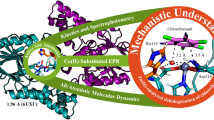Summary
Octoclothepine-N-oxide is reduced to octoclothepine by rat liver microsomes in the presence of NADPH under anaerobic conditions. Carbon monoxide and oxygen inhibit this reaction. SKF 525A slightly stimulated the reduction rate of octoclothepine-N-oxide. Kinetic data for this enzymic reduction suggest a high affinity of the microsomal enzyme system toward the N-oxide. This biotransformation reaction may represent a mechanism for regulation of drug level in patients.
Similar content being viewed by others
References
Jilek J., Metysová J., Pornykacek J. and Protiva M. (1968): Neurotrope und psychotrope Substanzen XIX. 8-Halogenderivate von 10-/4-Methylpiperazino/-10,11-dihydrodibenzo(b,f)-thiepin und verwandte Substanzen. Collection Czechoslov. Chem. Commun.,33, 1831–1845.
Metysová J. and Metys J. (1967): Comparative study on pharmacological properties of neuroleptics octoclothepine and chlorpromazine. Activ. nerv. super. (Praque),9, 424–425.
Queisnerová M., Svátek E., Macek K. and Metysová J. (1968): Contribution to biotransformation of thiepin derivates (octoclothepin and perathiepin) in vivo. Activ. nerv. super. (Praque),10, 335–336.
Queisnerova M., Svátek E. and Metysová J. (1969): Metabolites of octoclothepine eliminated in human and rat urine. Biochem. J.,114, 339–342.
Jindrová N. (1978): Ueber Gallenmetaboliten von Octoclothepin bei der phenobarbitalvorbehandelten Ratte. Pharmazie,33, 539–540.
Jindra A. and Jindrová N. (1979): Oxidative Biotransformation des Clotepins (Octoclothepin) in Lebermikrosomen. Pharmazie,34, 852.
Bickel M. H. (1969): The pharmacology and biochemistry of N-oxides. Pharmacol. Rev.,21, 325–355.
Sugiura M., Iwasaki K., Noguchi H. and Kato R. (1974): Evidence for the involvement of cytochrome P-450 in Tiaramide N-oxide reduction. Life Sci.,15, 1433–1442.
Sugiura M., Iwasaki K. and Kato R. (1976): Reduction of tertiary amine N-oxides by liver microsomal cytochrome P-450. Mol. Pharmacol.,12, 322–334.
Iwasaki K., Noguchi H., Kato R., Imai Y. and Sato R. (1977): Reduction of tertiary amine N-oxide by purified cytochrome P-450. Biochem. Biophys. Res. Commun.,77, 1143–1149.
Cinti D.L., Moldeus P. and Schenkman J.B. (1972): Kinetic parameters of drug-metabolizing enzymes in Ca2+-sedimented microsomes from rat liver. Biochem. Pharmacol.,21, 3249–3256.
Stahl E. (1969): Thin-Layer Chromatography, Springer Verlag, Berlin, p. 101.
Author information
Authors and Affiliations
Rights and permissions
About this article
Cite this article
Helia, O., Vargova, E. & Jindra, A. Reduction of octoclothepine-N-oxide by rat liver microsomes. European Journal of Drug Metabolism and Pharmacokinetics 6, 155–158 (1981). https://doi.org/10.1007/BF03189483
Received:
Issue Date:
DOI: https://doi.org/10.1007/BF03189483




